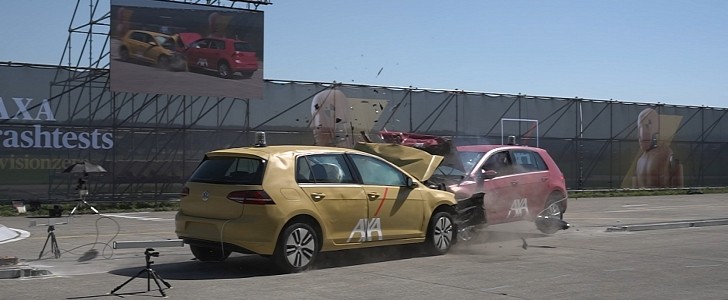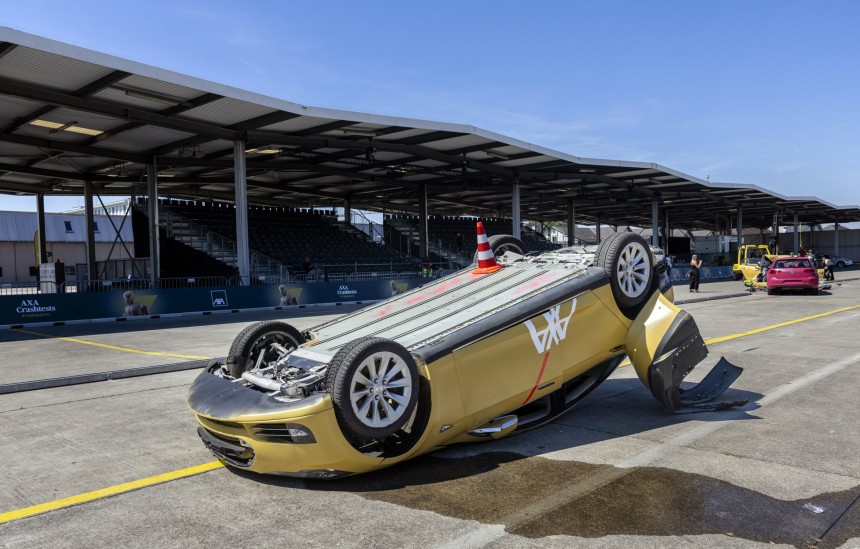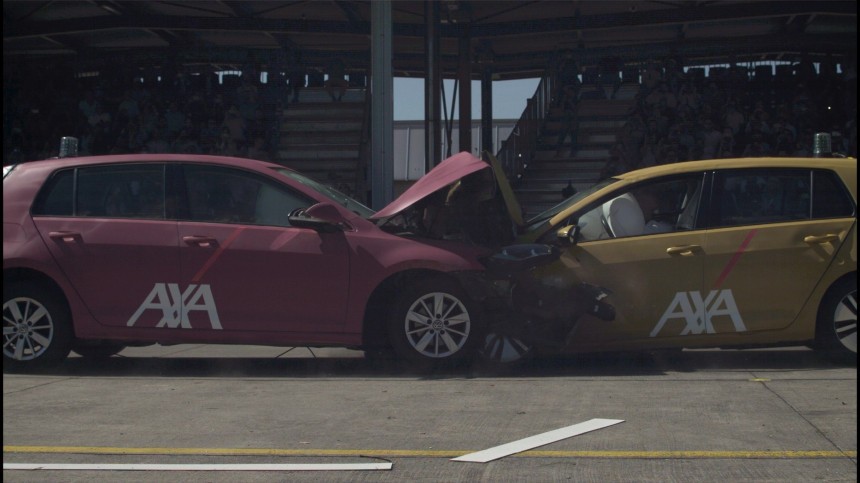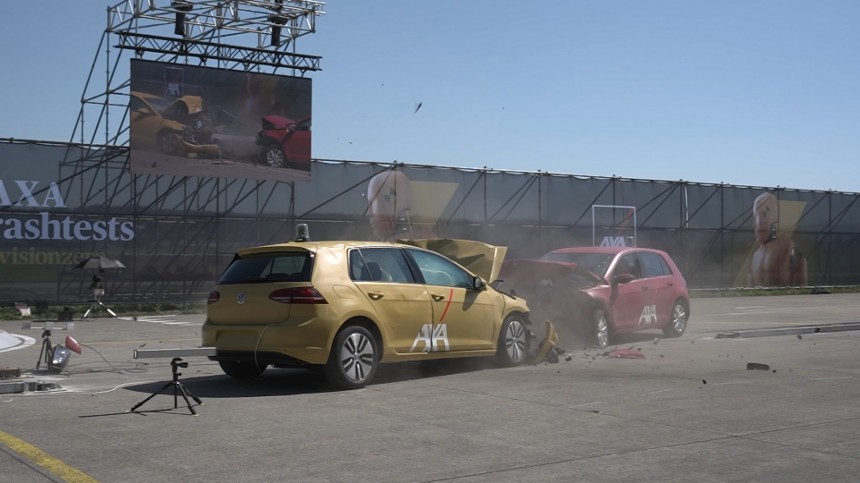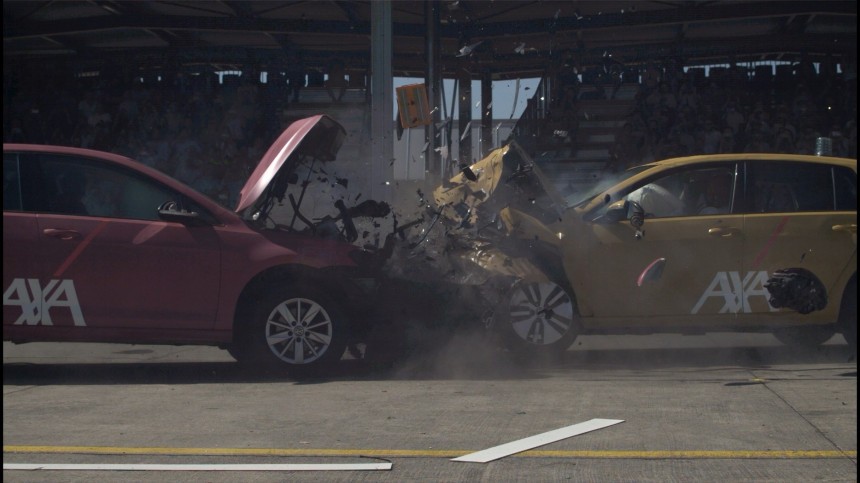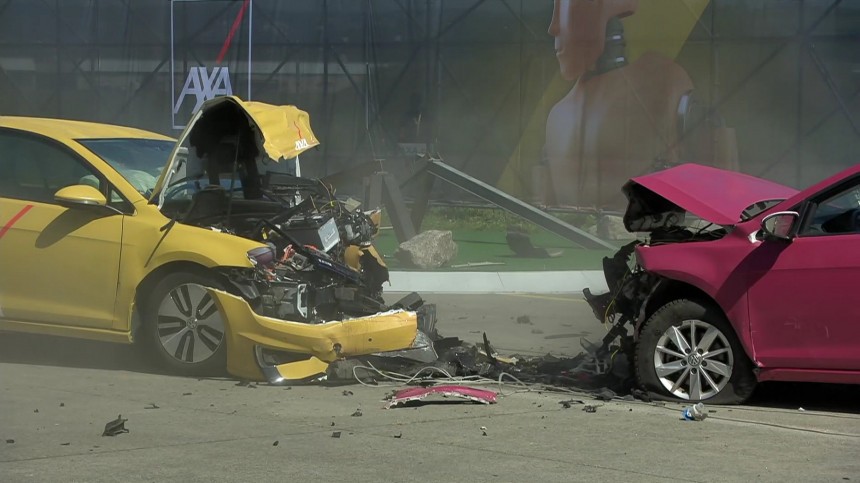AXA Insurance felt the effects of the mess it caused when it staged a fire with a Tesla Model S. The company decided to publicly apologize for how it failed to inform the public about the stunt’s procedures. Curiously, its excuse maintains that the tests were justifiable for the message it wanted to share. The point it wanted to make was that EVs caused more collisions due to their swift acceleration and that battery packs lacked due protection.
According to AXA, it “wanted to draw attention to these statistical findings with this year's crash tests and at the same time raise awareness of the dangers that can arise in accidents involving battery-powered cars.” This argument, however, makes it even stranger that the company removed the battery pack from the Model S it used in the test.
The statistics AXA talked about were that “drivers of electric cars cause 50 percent more collisions with damage to their own vehicles than drivers of conventional combustion engines.” They “also show that drivers of more powerful electric vehicles more often cause damage to their own vehicles or third-party vehicles.”
The insurance company reiterated that it performed the crash test without the battery pack “to ensure the safety of the audience in attendance.” However, a new argument emerged that is very intriguing. According to AXA, “the crash test with a Tesla brand model on the underbody of the car did not cause such damage that a battery fire would have been likely, as the pictures suggested.”
That makes things even worse for the insurance company. If the car would not have caught fire with the impairment, why set it on fire? To prove that the underbody is not protected enough? What if the car was so much lighter without the battery pack that the damage could not be compared to that of a vehicle more than half a ton heavier? Simplifying everything, why wasn’t the car tested in its original state if AXA wanted to prove it could catch fire? If the crash was dangerous for the audience, AXA should have performed it in a location without people. It could have recorded it or even broadcast it live.
The whole thing gets even more difficult to explain after the company decided to show how EVs are more dangerous for being heavier. To demonstrate that, it crashed a Volkswagen Golf against an e-Golf. Being heavier, the electric Volkswagen should have imposed a lot of damage on its regular derivative.
In its seventh generation, the lightest Golf tipped the scale at 1,205 kg (2,657 lb). The e-Golf weighed 1,510 kg (3,330 lb). In other words, the weight difference corresponded to about 25% of the lightest Golf’s mass. AXA presents different numbers: it states the combustion-engined Volkswagen used in the test weighed 1,250 kg (2,755.8 lb) and that the e-Golf was 400 kg heavier, which suggests it weighed 1,650 kg (3,637.6 lb). That would make the mass difference around 30% of the weight of the lighter Golf.
AXA argues that the ICE Golf “is exposed to a significantly higher load in this crash and consequently suffers visibly greater body damage than its electric counterpart.” That is not what the videos it released show.
The windshield is cracked in both cars at the bottom of the left A-pillar. Both seem to have a driver’s door that can be opened after the collision, one of the requirements for rescuing crash victims more quickly. AXA should be more specific about the “greater body damage” that no one can see. In fact, the yellow e-Golf seems to be much more battered than the red combustion-engined unit, but that’s because AXA selected one that was already in bad shape.
Did AXA remove the battery pack from the e-Golf “to ensure the safety of the audience in attendance?” The insurance company did not disclose if that was the case. That would be a possible explanation for no Golf presenting more damage than the other. Another justification is that the e-Golf has a small battery pack. It started its career with a 24.2-kWh unit that weighed 318 kilograms (701 pounds), upgraded in 2015 to 35.8 kWh.
The Opel Corsa-e has a 50-kWh battery pack that weighs 345 kg (780.4 lb) in a 1,530-kg (3,373-lb) vehicle. The lightest Corsa weighs 980 kg (2,160.5 lb). The weight difference corresponded to 50% of the lightest Corsa’s mass. If AXA wanted to show how two units of the same model fare differently in a crash when one is an EV, this would probably be a better example.
Yet, we suspect the result would be similar to that obtained by the Golfs because these cars are designed to comply with frontal offset tests. When they use a trolley, it usually weighs 1,400 kg (3,086.5 lb), but most tests use a fixed barrier with a deformable element. Either the crash is performed at 50 kph (31.1 mph) with the 1,400-kg trolley or at 64 kph (39.8 mph) with the fixed barrier to simulate two vehicles crashing at 50 kph. That’s the speed AXA used with the two Golfs.
A more representative test would have involved two vehicles from the same market segment, one with a combustion engine and the other electric. Think of a Porsche Taycan (2,140 kg, or 4,717.9 lb) crashing against a Mercedes-Benz E-Class (the lightest one weighs 1,605 kg or 3,538 lb). That’s a 535-kg (1,179.5-lb) difference. The heaviest Taycan weighs 2,305 kg (5,081.7 lb), which makes the mass difference reach 700 kg (1,543.2 lb). Although such a crash test would be more symbolic, it would also be a lot more expensive.
The bottom line is that AXA decided to prove electric cars need battery packs to be more protected while using a vehicle without that component. It also wanted to show their higher mass can be harmful to other cars in a crash test where the two vehicles ended up with exactly the same damages. The fiasco only made people doubt the statistical findings it wanted to share. If that was the company’s goal, mission accomplished.
The statistics AXA talked about were that “drivers of electric cars cause 50 percent more collisions with damage to their own vehicles than drivers of conventional combustion engines.” They “also show that drivers of more powerful electric vehicles more often cause damage to their own vehicles or third-party vehicles.”
That makes things even worse for the insurance company. If the car would not have caught fire with the impairment, why set it on fire? To prove that the underbody is not protected enough? What if the car was so much lighter without the battery pack that the damage could not be compared to that of a vehicle more than half a ton heavier? Simplifying everything, why wasn’t the car tested in its original state if AXA wanted to prove it could catch fire? If the crash was dangerous for the audience, AXA should have performed it in a location without people. It could have recorded it or even broadcast it live.
In its seventh generation, the lightest Golf tipped the scale at 1,205 kg (2,657 lb). The e-Golf weighed 1,510 kg (3,330 lb). In other words, the weight difference corresponded to about 25% of the lightest Golf’s mass. AXA presents different numbers: it states the combustion-engined Volkswagen used in the test weighed 1,250 kg (2,755.8 lb) and that the e-Golf was 400 kg heavier, which suggests it weighed 1,650 kg (3,637.6 lb). That would make the mass difference around 30% of the weight of the lighter Golf.
AXA argues that the ICE Golf “is exposed to a significantly higher load in this crash and consequently suffers visibly greater body damage than its electric counterpart.” That is not what the videos it released show.
Did AXA remove the battery pack from the e-Golf “to ensure the safety of the audience in attendance?” The insurance company did not disclose if that was the case. That would be a possible explanation for no Golf presenting more damage than the other. Another justification is that the e-Golf has a small battery pack. It started its career with a 24.2-kWh unit that weighed 318 kilograms (701 pounds), upgraded in 2015 to 35.8 kWh.
Yet, we suspect the result would be similar to that obtained by the Golfs because these cars are designed to comply with frontal offset tests. When they use a trolley, it usually weighs 1,400 kg (3,086.5 lb), but most tests use a fixed barrier with a deformable element. Either the crash is performed at 50 kph (31.1 mph) with the 1,400-kg trolley or at 64 kph (39.8 mph) with the fixed barrier to simulate two vehicles crashing at 50 kph. That’s the speed AXA used with the two Golfs.
The bottom line is that AXA decided to prove electric cars need battery packs to be more protected while using a vehicle without that component. It also wanted to show their higher mass can be harmful to other cars in a crash test where the two vehicles ended up with exactly the same damages. The fiasco only made people doubt the statistical findings it wanted to share. If that was the company’s goal, mission accomplished.
